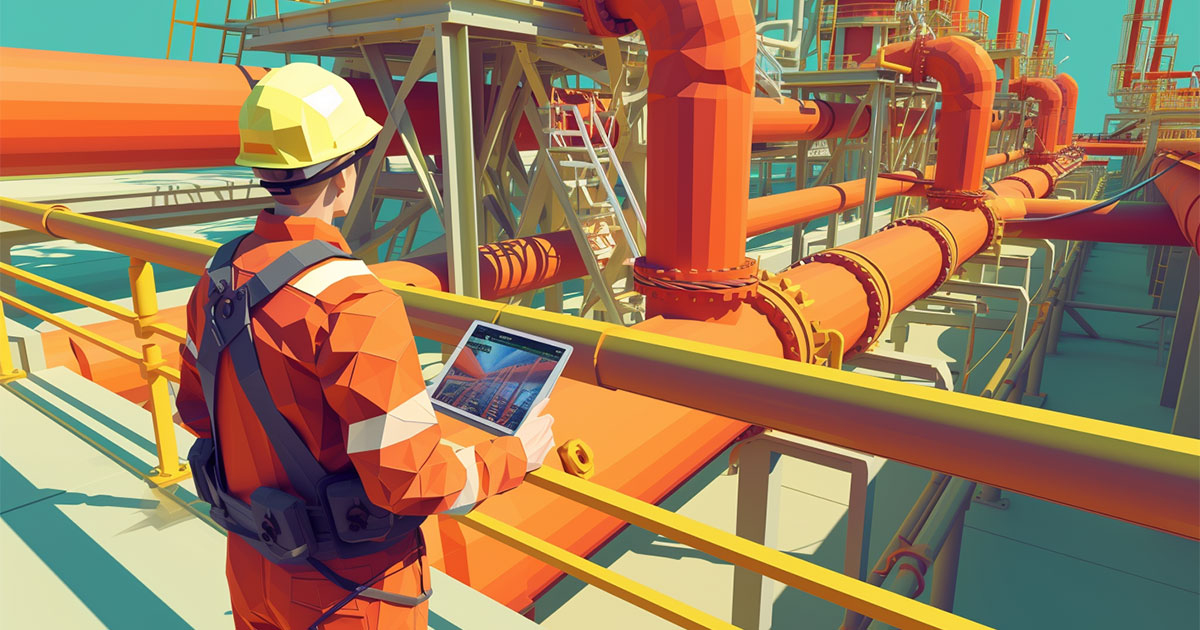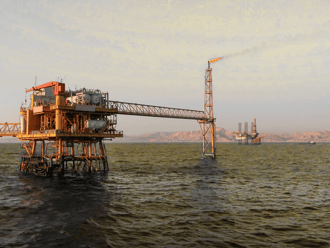May 21, 2024
The benefits of a digital-first approach to LNG facility construction

Imagine constructing an asset in a very remote location
It’s hundreds of miles away from the nearest office, and the workforce consists of half as many operators available to do the work. Travel to and from this asset is expensive, as is the cost of operations. This lean staffing requires extreme focus on the execution of work, and the operators you do have need to do their tasks more efficiently.
Shift handovers must be quick and efficient, and information needs to be provided in one system that can update all registers accordingly to prevent unnecessary double work. It’s also important to be able to support onsite workers at the asset remotely – something that’s possible only when people have remote access to what is happening at the asset in real time.
This is the reality for many LNG projects, and one that encourages companies to consider a digital approach to facility design and construction. But what exactly is the value of having an operational digital twin at hand during the project phase of an LNG facility? In this blog, we will explain how assets can benefit from a digital performance model approach to facility construction and expansion projects.
Quick recap of typical challenges between operators and EPC contractors
Let’s start with some typical pain points that companies experience during construction. As an operator, you are probably familiar with these so we’ll just do a quick recap before moving on to the good part: the top benefits of a digital-first approach that can help you create value already from the project phase right through to operations, setting the standard for the future of how assets will operate and maximise value throughout the asset's lifecycle.
In the domain of LNG projects, operators and EPC (Engineering, Procurement and Construction) contractors confront distinct challenges that call for close collaboration and problem-solving. From budget overruns to quality control challenges, limited data access and gaps in the data being handed over (30% of data typically gets lost in the process!), any project is susceptible to pain points that majorly impact project costs and timelines.

Top six pain points between clients and EPC contractors:
- Facility design: costly changes and rework due to poor design, long-term operational inefficiencies, misalignment and miscommunication
- Data access: Missing, incomplete and lost data, handed over at a late stage
- Safety risks: Difficulty aligning safety protocols and practices
- Quality control: Disagreements over the quality of materials and workmanship
- Budget overruns: Resulting from changes in scope or inaccurate initial estimates
- Resource allocation: Delayed procurement of materials, equipment and manpower
The earlier, the higher the value from an operational digital twin during projects
When a digital twin is part of a project right from the start, contractors can seize the opportunity to build the digital asset first and connect data – historical and real-time – as the asset is constructed and slowly comes to life. This digital-first approach ties the planning and execution phases together through enhanced visualisation, simulation and human-technology interaction. The diagram below shows how a digital-first approach differs from the traditional approach during the construction phase.

Major operators like LNG Canada have proven the potential of a digital-first approach to improve operational efficiency, even before and while a facility is being built.
“I started to look at the architecture and different components of digital, and it was obvious that the desire is to have one entry point for my people to go do their work. We had a digital twin as a box on the page, and it made sense to look at its capabilities around integration, data and visualisation. If we add a couple more components within the workflow space in the digital twin, it becomes very powerful.” – James Maguire, Digital and Business Transformation Manager LNG Canada, speaking at the Tomorrow Show 2023 (Houston, USA)
Key benefits that a digital twin offers greenfield assets and projects under construction
The sections below detail how a digital-first approach with digital twin technology can solve many of the challenges between contractors and operators.
Facility design
Build the facility to be digital by design
With a digital twin as a central repository for data and information, operators can design a facility based on analytics to reduce instrumentation, model and monitor corrosion (as opposed to just inspecting) and embed a performance architecture that enables more autonomous execution over time to reduce CAPEX and future OPEX.
Top 3 benefits:
- Implement a digital red thread with end-to-end workflows available in the twin, from the FEED stage through to construction and operations.
- Embed a culture of adaptability and innovation from the moment the facility is designed.
- Improve operational efficiency for the long-term by designing and operating the facility with digital tools and analytics.
Data access
Access data and monitor construction status remotely
The digital twin offers a centralised, cloud-based environment for vendors and operators to store and access data globally. From the start, vendors can use the twin to populate data, models and documents, making it both a place to store maintenance records, drawings and technical documentation and a repository for regular push releases to the operator for acceptance. Data hierarchy can be built out accurately and relationships between tags and documents can be validated as early as possible.
Top 3 benefits:
- Real-time overview of construction progress and site safety conditions. A digital twin will allow access to data at your fingertips, right where and when you need it.
- Data quality control for higher accuracy and faster data loads at a lower cost through twin contextualisation pipelines.
- Data is consistent, accurate and updated, facilitating regular updates for operator review.
Safety risks
Improve safety and efficiency with simulation for start-up and training
Digital twins don’t just model a physical site virtually – they also model equipment, systems and behaviours in real time, with simulation capabilities offering a glimpse into possible futures. Simulation capabilities in a digital twin help identify, assess and mitigate risks, providing a virtual environment where activities can be planned while considering sensitive work areas and potential conflicts on the construction site.
Top 3 benefits:
- Run ‘what-if’ scenarios and simulate construction tasks to optimise processes and identify bottlenecks for faster project completion.
- Testing and verification of start-up logic and equipment performance.
- Emissions estimation and reporting through virtual metering.
Budget overruns
Remote work, virtual site walks, digital commissioning and staff training
Digital ways of working enable remote collaboration, allowing roughly 15% of workers normally required to be on site during construction to work remotely resulting in a reduction of risk and costs. 2D and 3D capabilities allow planners to find equipment, take measurements and get an instant overview of upcoming and approved work orders and permits. Virtual site orientation, technical awareness and the transfer of knowledge become easily accessible for everyone from field workers to project stakeholders.
Top 3 benefits:
- Speed up project timelines and reduce the cost of site visits by activating remote workers.
- Train staff in a digital environment.
- Explore a site virtually to see the site’s as-built condition at any point in time, as well as upcoming work and how systems and equipment will operate after start-up.
Resource allocation
Enhanced digital collaboration and construction activity coordination
Operators can share and discuss important construction activities with architects, engineers, contractors and subcontractors while all parties have the exact same view of the physical site presented digitally. On-site and remote roles can coordinate in the digital twin environment to map out the most optimal flow for field assessments, minimizing the impact on construction activities underway and freeing up valuable resources to focus on more important tasks.
Top 3 benefits:
- Track progress of site activities and allocated resources.
- Monitor resource usage and identify deviations.
- Facilitate better communication with a central digital platform for planning.
Quality control
Digital quality control
A mature digital twin integrates the latest technologies, including Machine Learning and Artificial Intelligence, to help operators implement quality control from the construction phase through to operations. During construction, twin contextualisation pipelines enable higher accuracy and faster data processing load times at a lower cost.
Top 3 benefits:
- Move from reactive and preventive maintenance to predictive and more automated technical monitoring.
- Benefit from digital workflows with built-in quality control.
- Enhanced data accuracy and efficiency, reducing costs associated with rework or errors; built in AI capabilities can support users in their decision making.
A digital twin for design and planning
The digital operating model presents a new mindset and culture, allowing people in the organisation to see and monitor important parameters like ongoing activities, changes in project scope and timelines, and probable construction disruptions due to schedule delays. Even better, users and stakeholders have enough data and insights at hand to make better decisions, intervene early and mitigate potential risks.

When data is captured and integrated throughout the lifecycle of a project, benefits like performance optimization, efficient asset management and timely maintenance become tangible, leading to improved longevity and sustainability of the new facility over its entire life. When it’s presented in a digital twin, users get to work with the latest technology that helps them be productive and effective in the safest, smartest and most intuitive way possible.
At Kongsberg Digital, we know that no customer is the same, and although challenges are often similar, they are never exactly the same. We take a data-driven approach when we work with customers. We like to follow the data – your business data – to establish where a digital twin can deliver value, and which use cases will deliver value quickly and at scale.
Contact one of our experts
Want to learn more about the benefits of Kongsberg Digital’s Industrial Work Surface for construction through operations or discuss your own project?
Author

Yorinde Lokin-Knegtering
Growth Manager Americas



.png?width=330&height=330&name=The%20gap%20between%20strategic%20intent%20and%20practical%20execution%20(1).png)